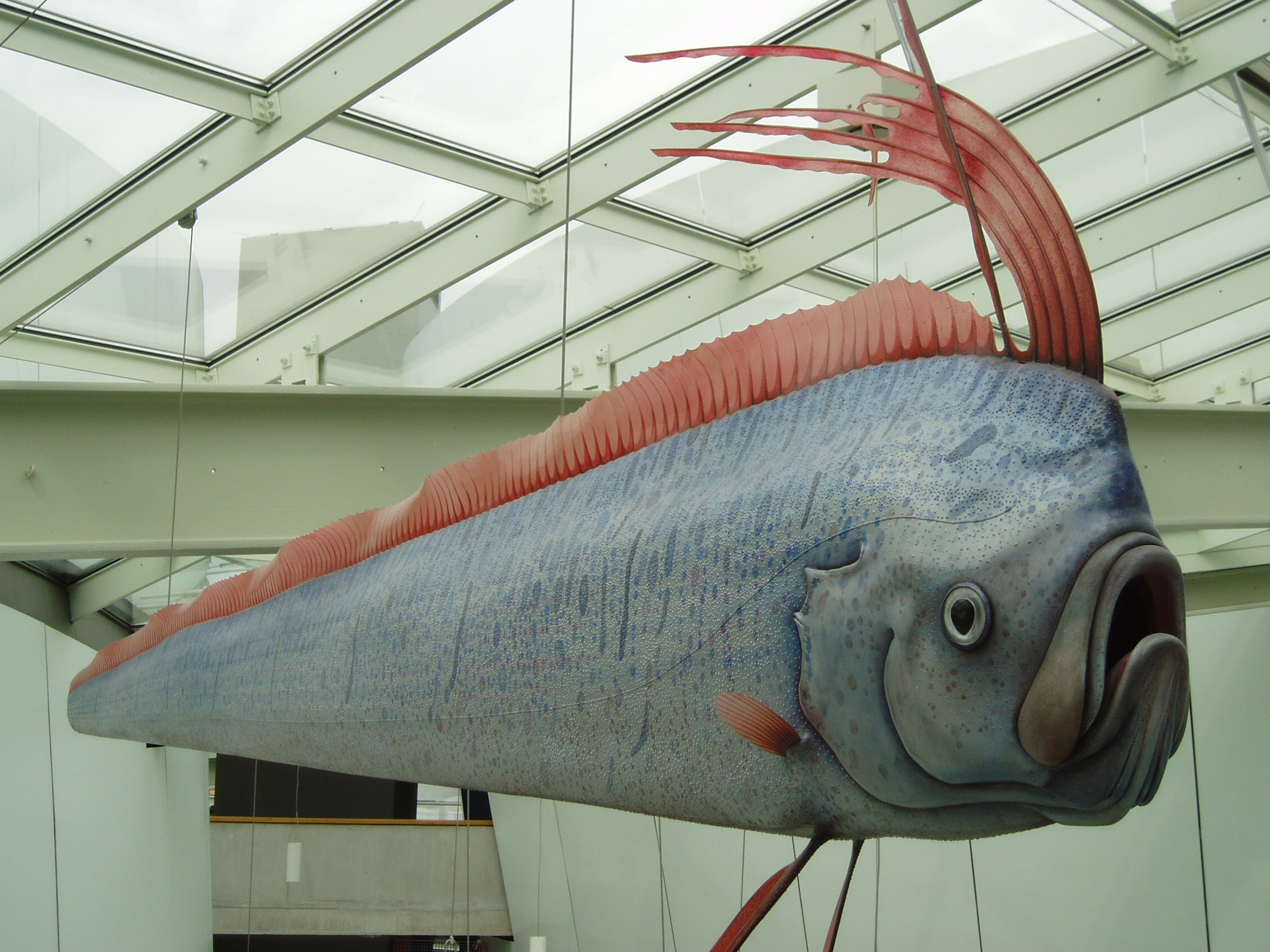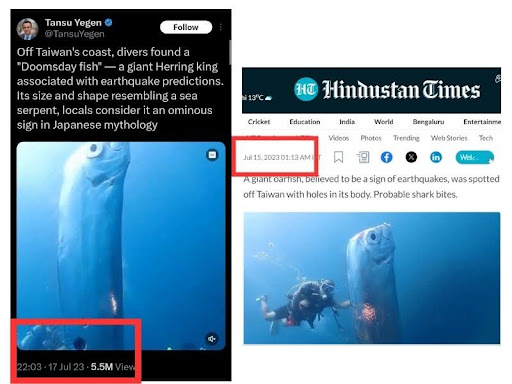By: vivek j
January 17 2024
Oarfish as a precursor to natural disasters: Myth or fact?

A model of the giant oarfish or Regalecus glesne. (Source: Flickr/Udo Schröter)
The January 1 earthquake in Japan has reignited interest in the giant oarfish, often dubbed the ‘doomsday’ fish in ancient Japanese folklore. Following the earthquake on Japan’s Noto Peninsula, which registered a magnitude of 7.6, a video of a giant oarfish circulated widely. Claims suggested it was spotted by deep-sea divers mere hours before the quake.
This event sparked debates on social media regarding the Japanese myth linking these fish to impending natural disasters. A TikTok video, for example, claimed that the oarfish sighting off the Taiwanese coast occurred just hours before the January 1 earthquake (archived here).
Screenshot of the viral TikTok video. (Source: TikTok/Screenshot/Modified by Logically Facts)
But the truth is the viral video was shot near Taiwan and dates back to July 2023. It was uploaded by the official YouTube channel of the Australian news website news.com.au. Multiple other sources from that period corroborate this finding.

Screenshots from a social media post and a news article from July 2023. (Source: X/Hindustan TimesScreenshot)
The Japanese myth
In Japanese folklore, the oarfish is considered an omen of impending natural disasters like earthquakes or tsunamis. Known in Japan as “Ryugu no Tsuki” or “messenger from the sea god’s palace,” it has long been believed that the oarfish surfaces from its deep-sea habitat when human lives are in danger. This belief has garnered global attention, earning the oarfish the moniker of “doomsday fish.”
Oarfish are deep-sea dwellers, typically reaching lengths of up to 36 feet and weighing around 600 pounds. First described as Regalecus glesne in 1772, they belong to the Regalecidae family. Their elusive nature fuels various superstitions linked to their sightings.
Historical sightings and correlations
Speculation about oarfish as earthquake harbingers isn't new. In 2011, multiple oarfish sightings in Japan preceded the catastrophic earthquake and tsunami in March. Similarly, in California, sightings along Santa Catalina and Santa Monica shores in 2013, 2014, and 2015 prompted searches for a connection to seismic activity, although none was established. Notably, an article in Forbes reported no link between these sightings and the San Andreas fault.
In August 2017, two oarfish washed ashore near the Philippines before a magnitude 6.6 earthquake in Luzon, located approximately 800 miles from the epicenter. However, similar sightings in 2019 before the Yamagata earthquake in Japan, reported by CNN in February 2019, also lacked conclusive correlation.
What do experts say?
“There is no evidence that I know of to suggest that oarfish come into shallow waters in response to, or preparation of, earthquakes,” said Dr. Milton Love of the Marine Science Institute, University of California, Santa Barbara.
While stating that there may be some hypothetical correlation between earthquakes and the appearance of oarfish, he noted that the opposite appears to be true as there were many instances throughout the world when oarfish got beached and there was no earthquake.
Similarly, a study titled “Is Japanese Folklore Concerning Deep-Sea Fish Appearance a Real Precursor of Earthquakes?” found minimal correlation between oarfish sightings and seismic events, suggesting the folklore might be based on illusory correlation.
Several other experts agree. Dr. Yoshiaki Orihara, Professor of Physics at Tokyo Gakugei University, emphasized the lack of direct evidence linking oarfish appearances to natural disasters. “The absence of evidence is not evidence of absence. We compared 336 occurrences of deep-sea fish appearances with 221 earthquakes, and only one event showed a plausible correlation.”
To understand if marine life can detect tsunamis or present any shift in behavioral patterns during such natural disasters, we reached out to Professor Kusala Rajendran, an Indian seismologist and a professor at the Centre for Earth Sciences, Indian Institute of Science, Bengaluru. He told Logically Facts that, “The withdrawal of the shoreline during tsunamis can expose fish, and they may die. But I am not aware of any other way the animals would be affected.”
What causes oarfish to leave deep-sea habitat and surface?
One possible explanation, Dr. Milton Love suggests, is that ocean dynamics might accidentally bring oarfish to shallow waters. While Dr. Orihara points to possible weakening or updraft currents in the Japan Sea as factors in increased oarfish sightings.
“January and February stand out as the prominent months for oarfish sightings around the Japan Sea. A hypothesis suggests that updraft water currents occur in the Japan Sea during winter seasons. Consequently, it is speculated that some oarfish might be transported from the seabed to the surface by these updraft currents,” Dr. Orihara added.
Weather patterns may also play a part. A South California Academy of Sciences bulletin, cited by Forbes, correlates oarfish strandings with El Nino years, linking surface temperatures and oarfish feeding habits. “During an El Niño, the temperature at the surface is several degrees higher than the average while at deeper depths, where the fish live, the water is cooler than usual. Oarfish feed on plankton and tiny fish, which follow the warmer water as the oarfish follows its preferred food to the surface.”
In conclusion, while the oarfish has often surfaced before earthquakes and tsunamis, there's no consistent timeframe or conclusive evidence of a direct relationship. It's noteworthy that oarfish sightings have occurred without subsequent earthquakes, further challenging the myth of their predictive or “doomsday” nature.
(Edited by Nitish Rampal)


